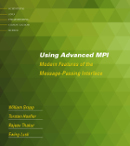Home
Publications
edited volumes
Awards
Research
Teaching
Miscellaneous
Full CV [pdf]
ew-hoefe
BLOG
bio


Events





Past Events






|
Publications of Torsten Hoefler
B. Prisacari, G. Rodriguez, P. Heidelberger, D. Chen, C. Minkenberg, Torsten Hoefler:
| | | Efficient Task Placement and Routing in Dragonfly Networks
(In Proceedings of the 23rd ACM International Symposium on High-Performance Parallel and Distributed Computing (HPDC'14), presented in Vancouver, Canada, ACM, Jun. 2014)
AbstractDragonflies are recent network designs that are one of the
most promising topologies for the Exascale effort due to their
scalability and cost. While being able to achieve very high
throughput under random uniform all-to-all traffic, other
widely used workloads in high performance computing, such
as the Cartesian nearest neighbor communication pattern,
experience a significant performance degradation, and have
been termed as ‘pathological’ patterns for Dragonfly networks.
Despite the importance of the Cartesian nearest neighbor
pattern as a basic building block for most scientific applications, there is as of now, no detailed theoretical model which
can predict its performance accurately on a dragonfly topology taking into account (i) the network parameters (number
of links and bandwidths per level) (ii) the routing function
used in the network (direct/indirect) and (iii) the placement on the network (random, hierarchical, etc.). Such a
theoretical model would establish the real performance expectation for this communication pattern, as well as help
determine the parameters that would lead to an optimum
performance.
In this work we present such a theoretical performance
analysis framework, which, taking as input (i) a network
specification, (ii) the domain decomposition parameters from
which the nearest neighbor communication pattern emerges,
and (iii) a task placement description, can predict the impact on the effective sustained injection bandwidth. Our
analysis is able to provide analytic bounds for the peformance of the neareat neighbor exchange across a multitude
of possible task-to-node maping strategies. Finally, using
a comprehensive set of simulations results, we validate the
correctness of the theoretical approach and in the process
address some misconceptions regarding Dragonfly network
behavior and evaluation, (such as the choice of throughput
maximization over workload completion time minimization
as optimization objective) and the question of whether the
standard notion of a balanced Dragonfly (topological parameters chosen for near-optimum performance for uniform
random all-to-all traffic) can be extended to workloads other
than uniform random traffic. To this end we conclude that
the optimal performance/cost Dragonfly network design for
uniform random all-to-all traffic is different to the optimal
performance/cost Dragonfly network design for the Cartesian nearest neighbor pattern.
Documentsdownload article: 
| | | BibTeX | @inproceedings{prisacari-dragonfly-mapping,
author={B. Prisacari and G. Rodriguez and P. Heidelberger and D. Chen and C. Minkenberg and Torsten Hoefler},
title={{Efficient Task Placement and Routing in Dragonfly Networks }},
year={2014},
month={Jun.},
booktitle={Proceedings of the 23rd ACM International Symposium on High-Performance Parallel and Distributed Computing (HPDC'14)},
location={Vancouver, Canada},
publisher={ACM},
source={http://www.unixer.de/~htor/publications/},
} |
|
|



























